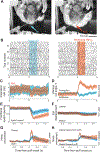A brainstem circuit for the expression of defensive facial reactions in rat
- PMID: 37703878
- PMCID: PMC11034846
- DOI: 10.1016/j.cub.2023.08.041
A brainstem circuit for the expression of defensive facial reactions in rat
Abstract
The brainstem houses neuronal circuits that control homeostasis of vital functions. These include the depth and rate of breathing1,2 and, critically, apnea, a transient cessation of breathing that prevents noxious vapors from entering further into the respiratory tract. Current thinking is that this reflex is mediated by two sensory pathways. One known pathway involves vagal and glossopharyngeal afferents that project to the nucleus of the solitary tract.3,4,5 Yet, apnea induced by electrical stimulation of the nasal epithelium or delivery of ammonia vapors to the nose persists after brainstem transection at the pontomedullary junction, indicating that the circuitry that mediates this reflex is intrinsic to the medulla.6 A second potential pathway, consistent with this observation, involves trigeminal afferents from the nasal cavity that project to the muralis subnucleus of the spinal trigeminal complex.7,8 Notably, the apneic reflex is not dependent on olfaction as it can be initiated even after disruption of olfactory pathways.9 We investigated how subnucleus muralis cells mediate apnea in rat. By means of electrophysiological recordings and lesions in anesthetized rats, we identified a pathway from chemosensors in the nostrils through the muralis subnucleus and onto both the preBötzinger and facial motor nuclei. We then monitored breathing and orofacial reactions upon ammonia delivery near the nostril of alert, head-restrained rats. The apneic reaction was associated with a grimace, characterized by vibrissa protraction, wrinkling of the nose, and squinting of the eyes. Our results show that a brainstem circuit can control facial expressions for nocifensive and potentially pain-inducing stimuli.
Keywords: breathing; chemosensation; ethmoidal nerve; grimace; nasal epithelium; nociception; trigeminus.
Copyright © 2023 Elsevier Inc. All rights reserved.
Conflict of interest statement
Declaration of interests The authors declare no competing interests.
Figures




References
-
- Patrickson JW, Smith TE, and Zhou S-S (1991). Afferent projections of the superior and recurrent laryngeal nerves. Brain Research 539, 169–174. - PubMed
-
- Furusawa K, Yasuda K, Okuda D, Tanaka M, and Yamaoka M. (1996). Central distribution and peripheral functional properties of afferent and efferent components of the superior laryngeal nerve: morphological and electrophysiological studies in the rat. Journal of Comparative Neurology 375, 147–156. - PubMed
Publication types
MeSH terms
Substances
Grants and funding
LinkOut - more resources
Full Text Sources

